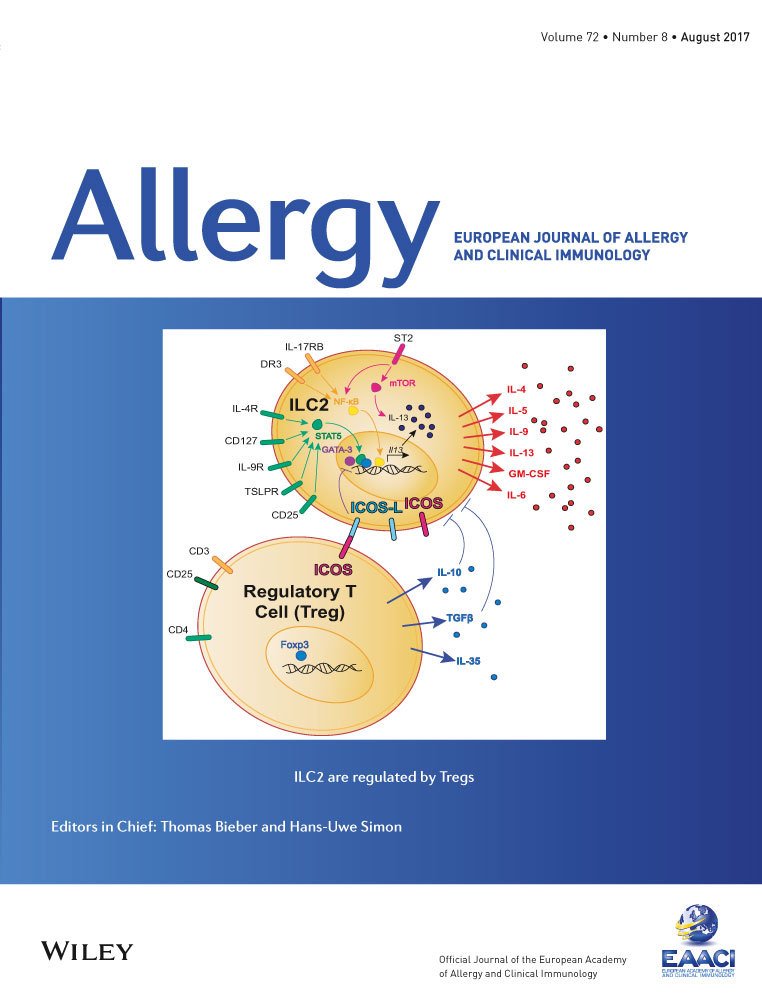Vitamin D contributes to mast cell stabilization
Z.-Q. Liu
The Research Center of Allergy & Immunology, Shenzhen University School of Medicine, Shenzhen, China
Longgang ENT Hospital, Shenzhen, China
Equally contributed to this work.Search for more papers by this authorX.-X. Li
The Research Center of Allergy & Immunology, Shenzhen University School of Medicine, Shenzhen, China
Equally contributed to this work.Search for more papers by this authorS.-Q. Qiu
The Research Center of Allergy & Immunology, Shenzhen University School of Medicine, Shenzhen, China
Longgang ENT Hospital, Shenzhen, China
Equally contributed to this work.Search for more papers by this authorY. Yu
The Fifth Hospital, Zhengzhou University, Zhengzhou, China
Equally contributed to this work.Search for more papers by this authorM.-G. Li
The Research Center of Allergy & Immunology, Shenzhen University School of Medicine, Shenzhen, China
Search for more papers by this authorL.-T. Yang
The Research Center of Allergy & Immunology, Shenzhen University School of Medicine, Shenzhen, China
Longgang ENT Hospital, Shenzhen, China
Brain Body Institute, McMaster University, Hamilton, ON, Canada
Search for more papers by this authorL.-J. Li
Brain Body Institute, McMaster University, Hamilton, ON, Canada
Search for more papers by this authorS. Wang
The Research Center of Allergy & Immunology, Shenzhen University School of Medicine, Shenzhen, China
Longgang ENT Hospital, Shenzhen, China
Search for more papers by this authorCorresponding Author
P.-Y. Zheng
The Fifth Hospital, Zhengzhou University, Zhengzhou, China
Correspondence
Dr. Ping-Chang Yang and Dr. Zhi-Gang Liu, Shenzhen University, Room 722 of Medical School Building, 3688 Nanhai Blvd, Shenzhen 518060, China.
Tel.: +8675586172722
Fax: +8675586671906
E-mails: [email protected] and [email protected]
and
Dr. Peng-Yuan Zheng, The Fifth Hospital, Zhengzhou University, 3 Kangqian Road, Zhengzhou 470000, China.
Tel.: +8637168327437
Fax: +8637168327438
E-mail: [email protected]
Search for more papers by this authorCorresponding Author
Z.-G. Liu
The Research Center of Allergy & Immunology, Shenzhen University School of Medicine, Shenzhen, China
Correspondence
Dr. Ping-Chang Yang and Dr. Zhi-Gang Liu, Shenzhen University, Room 722 of Medical School Building, 3688 Nanhai Blvd, Shenzhen 518060, China.
Tel.: +8675586172722
Fax: +8675586671906
E-mails: [email protected] and [email protected]
and
Dr. Peng-Yuan Zheng, The Fifth Hospital, Zhengzhou University, 3 Kangqian Road, Zhengzhou 470000, China.
Tel.: +8637168327437
Fax: +8637168327438
E-mail: [email protected]
Search for more papers by this authorCorresponding Author
P.-C. Yang
The Research Center of Allergy & Immunology, Shenzhen University School of Medicine, Shenzhen, China
Correspondence
Dr. Ping-Chang Yang and Dr. Zhi-Gang Liu, Shenzhen University, Room 722 of Medical School Building, 3688 Nanhai Blvd, Shenzhen 518060, China.
Tel.: +8675586172722
Fax: +8675586671906
E-mails: [email protected] and [email protected]
and
Dr. Peng-Yuan Zheng, The Fifth Hospital, Zhengzhou University, 3 Kangqian Road, Zhengzhou 470000, China.
Tel.: +8637168327437
Fax: +8637168327438
E-mail: [email protected]
Search for more papers by this authorZ.-Q. Liu
The Research Center of Allergy & Immunology, Shenzhen University School of Medicine, Shenzhen, China
Longgang ENT Hospital, Shenzhen, China
Equally contributed to this work.Search for more papers by this authorX.-X. Li
The Research Center of Allergy & Immunology, Shenzhen University School of Medicine, Shenzhen, China
Equally contributed to this work.Search for more papers by this authorS.-Q. Qiu
The Research Center of Allergy & Immunology, Shenzhen University School of Medicine, Shenzhen, China
Longgang ENT Hospital, Shenzhen, China
Equally contributed to this work.Search for more papers by this authorY. Yu
The Fifth Hospital, Zhengzhou University, Zhengzhou, China
Equally contributed to this work.Search for more papers by this authorM.-G. Li
The Research Center of Allergy & Immunology, Shenzhen University School of Medicine, Shenzhen, China
Search for more papers by this authorL.-T. Yang
The Research Center of Allergy & Immunology, Shenzhen University School of Medicine, Shenzhen, China
Longgang ENT Hospital, Shenzhen, China
Brain Body Institute, McMaster University, Hamilton, ON, Canada
Search for more papers by this authorL.-J. Li
Brain Body Institute, McMaster University, Hamilton, ON, Canada
Search for more papers by this authorS. Wang
The Research Center of Allergy & Immunology, Shenzhen University School of Medicine, Shenzhen, China
Longgang ENT Hospital, Shenzhen, China
Search for more papers by this authorCorresponding Author
P.-Y. Zheng
The Fifth Hospital, Zhengzhou University, Zhengzhou, China
Correspondence
Dr. Ping-Chang Yang and Dr. Zhi-Gang Liu, Shenzhen University, Room 722 of Medical School Building, 3688 Nanhai Blvd, Shenzhen 518060, China.
Tel.: +8675586172722
Fax: +8675586671906
E-mails: [email protected] and [email protected]
and
Dr. Peng-Yuan Zheng, The Fifth Hospital, Zhengzhou University, 3 Kangqian Road, Zhengzhou 470000, China.
Tel.: +8637168327437
Fax: +8637168327438
E-mail: [email protected]
Search for more papers by this authorCorresponding Author
Z.-G. Liu
The Research Center of Allergy & Immunology, Shenzhen University School of Medicine, Shenzhen, China
Correspondence
Dr. Ping-Chang Yang and Dr. Zhi-Gang Liu, Shenzhen University, Room 722 of Medical School Building, 3688 Nanhai Blvd, Shenzhen 518060, China.
Tel.: +8675586172722
Fax: +8675586671906
E-mails: [email protected] and [email protected]
and
Dr. Peng-Yuan Zheng, The Fifth Hospital, Zhengzhou University, 3 Kangqian Road, Zhengzhou 470000, China.
Tel.: +8637168327437
Fax: +8637168327438
E-mail: [email protected]
Search for more papers by this authorCorresponding Author
P.-C. Yang
The Research Center of Allergy & Immunology, Shenzhen University School of Medicine, Shenzhen, China
Correspondence
Dr. Ping-Chang Yang and Dr. Zhi-Gang Liu, Shenzhen University, Room 722 of Medical School Building, 3688 Nanhai Blvd, Shenzhen 518060, China.
Tel.: +8675586172722
Fax: +8675586671906
E-mails: [email protected] and [email protected]
and
Dr. Peng-Yuan Zheng, The Fifth Hospital, Zhengzhou University, 3 Kangqian Road, Zhengzhou 470000, China.
Tel.: +8637168327437
Fax: +8637168327438
E-mail: [email protected]
Search for more papers by this authorAbstract
Background and aims
Mast cells are the major effector cells in allergic disorders and many other informatory disorders. The mechanism of mast cell stabilization is not fully understood. Cumulative reports indicate that vitamin D (VitD) contributes to the homeostasis in the body. This study tests a hypothesis that VitD is required in the maintenance of the stability of mast cells.
Methods
The stability of mast cell lines, HMC1 cells, RBL-2H3 cells, p815 cells, and mouse bone marrow-derived mast cells (BMMC) was tested in the presence or absence of VitD3.
Results
Mast cells activated automatically in a VitD-deficient environment. Exposure to calcitriol in the culture increased the expression of VitD receptor (VDR) in mast cells. VDR formed complexes with Lyn in mast cells to inhibit the binding of Lyn to the β chain of FcεRI and MyD88, which decreased the phosphorylation of Syk, decreased the levels of MAPK and NF-κB. VDR bound to the promoter of TNF-α to decrease the acetylation of histone H3/H4, RNA polymerase II and OCT1 (a transcription factor of TNF-α) at the promoter locus and repressed the expression of TNF-α in mast cells.
Conclusions
The data demonstrate that VitD is required to maintain the stability of mast cells. The deficiency of VitD results in mast cell activation.
Abstract

References
- 1Wernersson S, Pejler G. Mast cell secretory granules: armed for battle. Nat Rev Immunol 2014; 14: 478–494.
- 2Lieberman P, Garvey LH. Mast cells and anaphylaxis. Curr Allergy Asthma Rep 2016; 16: 20.
- 3Finkelman FD, Khodoun MV, Strait R. Human IgE-independent systemic anaphylaxis. J Allergy Clin Immunol 2016; 137: 1674–1680.
- 4Afrin LB. Mast cell activation disease and the modern epidemic of chronic inflammatory disease. Transl Res 2016; 174: 33–59.
- 5Veatch SL, Chiang EN, Sengupta P, Holowka DA, Baird BA. Quantitative nanoscale analysis of IgE-FcepsilonRI clustering and coupling to early signaling proteins. J Phys Chem B 2012; 116: 6923–6935.
- 6Lin S, Cicala C, Scharenberg AM, Kinet JP. The Fc(epsilon)RIbeta subunit functions as an amplifier of Fc(epsilon)RIgamma-mediated cell activation signals. Cell 1996; 85: 985–995.
- 7Sibilano R, Frossi B, Pucillo CE. Mast cell activation: a complex interplay of positive and negative signaling pathways. Eur J Immunol 2014; 44: 2558–2566.
- 8Giulietti A, van Etten E, Overbergh L, Stoffels K, Bouillon R, Mathieu C. Monocytes from type 2 diabetic patients have a pro-inflammatory profile. 1,25-Dihydroxyvitamin D(3) works as anti-inflammatory. Diabetes Res Clin Pract 2007; 77: 47–57.
- 9Calton EK, Keane KN, Newsholme P, Soares MJ. The impact of vitamin D levels on inflammatory status: a systematic review of immune cell studies. PLoS One 2015; 10: 0141770.
- 10Sarkar S, Hewison M, Studzinski GP, Li YC, Kalia V. Role of vitamin D in cytotoxic T lymphocyte immunity to pathogens and cancer. Crit Rev Clin Lab Sci 2016; 53: 132–145.
- 11Wei R, Christakos S. Mechanisms underlying the regulation of innate and adaptive immunity by vitamin D. Nutrients 2015; 7: 8251–8260.
- 12Neve A, Corrado A, Cantatore FP. Immunomodulatory effects of vitamin D in peripheral blood monocyte-derived macrophages from patients with rheumatoid arthritis. Clin Exp Med 2014; 14: 275–283.
- 13Yip KH, Kolesnikoff N, Yu C, Hauschild N, Taing H, Biggs L et al. Mechanisms of vitamin D(3) metabolite repression of IgE-dependent mast cell activation. J Allergy Clin Immunol 2014; 133: 1356–1364.
- 14Feng BS, Zheng PY, Chen X, Liao XQ, Yang PC. Investigation of the role of cholera toxin in assisting the initiation of the antigen-specific Th2 response. Immunol Invest 2008; 37: 782–797.
- 15Jung H-S, Kim MH, Gwak N-G, Im Y-S, Lee K-Y, Sohn Y et al. Antiallergic effects of Scutellaria baicalensis on inflammation in vivo and in vitro. J Ethnopharmacol 2012; 141: 345–349.
- 16Consiglio M, Destefanis M, Morena D, Foglizzo V, Forneris M, Pescarmona G et al. The vitamin D receptor inhibits the respiratory chain, contributing to the metabolic switch that is essential for cancer cell proliferation. PLoS One 2014; 9: 115816.
- 17Ban T, Sato GR, Nishiyama A, Akiyama A, Takasuna M, Umehara M et al. Lyn kinase suppresses the transcriptional activity of IRF5 in the TLR-MyD88 pathway to restrain the development of autoimmunity. Immunity 2016; 45: 319–332.
- 18van Heel DA, Udalova IA, De Silva AP, McGovern DP, Kinouchi Y, Hull J et al. Inflammatory bowel disease is associated with a TNF polymorphism that affects an interaction between the OCT1 and NF-κB transcription factors. Hum Mol Genet 2002; 11: 1281–1289.
- 19Finn DF, Walsh JJ. Twenty-first century mast cell stabilizers. Br J Pharmacol 2013; 170: 23–37.
- 20Jeong YI, Kim YJ, Ju JW, Hong SH, Lee MR, Cho SH et al. Identification of anti-allergic effect of Clonorchis sinensis-derived protein venom allergen-like proteins (CsVAL). Biochem Biophys Res Commun 2014; 445: 549–555.
- 21Amir-Moazami O, Alexia C, Charles N, Launay P, Monteiro RC, Benhamou M. Phospholipid scramblase 1 modulates a selected set of IgE receptor-mediated mast cell responses through LAT-dependent pathway. J Biol Chem 2008; 283: 25514–25523.
- 22Meckel K, Li YC, Lim J, Kocherginsky M, Weber C, Almoghrabi A et al. Serum 25-hydroxyvitamin D concentration is inversely associated with mucosal inflammation in patients with ulcerative colitis. Am J Clin Nutr 2016; 104: 113–120.
- 23Kim JK, Seo YK, Park S, Park SA, Lim S, Lee S et al. Spiraeoside inhibits mast cells activation and IgE-mediated allergic responses by suppressing phospholipase C-gamma-mediated signaling. Biochem Cell Biol 2015; 93: 227–235.




